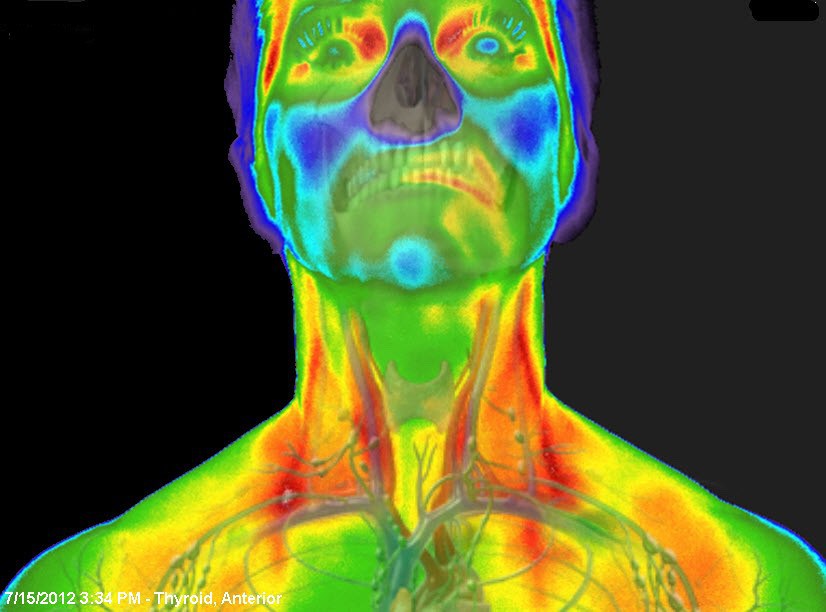About 2 percent of the United States population is affected by Fibromyalgia. That’s about five million people! Think about it: That’s as if every person in the great state of Colorado had fibromyalgia. Fibro is about seven times more common in women than men, and is more likely to develop in middle age and later in life.
What is Fibromyalgia?
Fibromyalgia is a long-term or chronic disorder. It’s associated with widespread pain in the muscles and bones, areas of tenderness, and general fatigue. Symptoms like these are considered subjective, meaning they can’t be determined or measured by tests. Because its symptoms are subjective and there isn’t a clear known cause, fibromyalgia is often misdiagnosed as another disease.
What are the symptoms of Fibromyalgia?
Fibromyalgia is often associated with areas of tenderness, which are called trigger points or tender points. These are places on your body where even light pressure can cause pain.
Today, these points are rarely used to diagnose fibromyalgia. Instead, they may be used as one way for doctors to narrow their list of possible diagnoses. Doctors use a combination of other consistent symptoms along with trigger points to help with diagnosis.
The pain caused by these trigger points can also be described as a consistent dull ache affecting many areas of your body. If you were to experience this pain for at least three months, doctors may consider this a symptom of fibromyalgia.
People with this disorder may also experience:
- fatigue
- trouble sleeping
- sleeping for long periods of time without feeling rested
- headaches
- depression
- anxiety
- inability to focus or difficulty paying attention
- pain or dull aching in the lower abdomen
Symptoms may be a result of the brain and nerves misinterpreting or overreacting to normal pain signals. This may be due to a chemical imbalance in the brain.
The primary cause of fibromyalgia pain is the depletion and decreased efficiency of stress-coping hormones like serotonin. This lowers the threshold and magnifies pain. This lower threshold causes pain that would normally be well-managed to be more pronounced. Pain due to a low pain threshold is known as allodynia.
There are numerous triggers for fueling the flames of fibromyalgia pain:
- Food sensitivities
- Joint traumas
- Osteoarthritis (wear and tear arthritis)
- Autoimmune arthritis, past surgeries (scars)
- Inflammation
- Leaky gut
- and many, many others
Basically, anything that increases inflammation increases the likelihood of pain, and in fibromyalgia a little inflammation can create a Lot of Pain!
Is there a Gut and Brain Connection?
Leaky gut equals leaky brain – it is all connected. Intestinal permeability (leaky gut) happens when the digestive tract lining leaks toxins into the bloodstream, which then trigger allergic reactions and inflammation. Toxins and inflammation both effect the brain and can contribute to headaches, fatigue, depression and brain fog. The autoimmune reaction to these toxins create pain all over the body, especially in areas of trigger points.
Many of my clients take heartburn medications or NSAID’s for heartburn and pain, but these drugs decrease the natural enzymes in the digestive system, which can make the lining permeable and cause leaky gut. These enzymes are depleted through prescription medications, NSAID’s, poor diet, steroids, antihistamines, antibiotics, excess alcohol and caffeine.
The popular NSAID, ibuprofen, is a big cause of leaky gut syndrome. It leads to stomach ulcers that can cause bleeding in the upper gastrointestinal tract, which would require surgery and blood transfusions to correct.
In addition to the above risks, NSAID’s also deplete melatonin, your natural sleep hormone, and increase blood pressure.
An elimination diet combining nutritional supplements, like L-glutamine, can help reverse leaky gut symptoms along with a gut restoration program implementing the 4 R program:
- Remove – offending substances from the diet
- Replace – digestive enzymes and stomach acid where necessary
- Reinoculate – the bowel with pre- and probiotics
- Regenerate – the gastrointestinal mucosa through proper nutritional support
Fibromyalgia Elimination Plan
Multiple clinical studies show that treating fibromyalgia symptoms require a multi-pronged approach that includes changes in diet and nutrition. A collaborative study from researchers in Italy have found that fibromyalgia patients can benefit from specific dietary changes and nutritional supplementation.
This study found that the elimination of gluten has the potential for improving symptoms of fibromyalgia. This result is echoed in another recent study published in Arthritis Research & Therapy, where researchers studied the effect of a one-year gluten-free diet in patients with co-occurring IBS and fibromyalgia.
In fact, one of the subgroups in the study experienced significant improvement in all symptoms and an improvement in quality of life scores.
Of foods to avoid when treating fibromyalgia, gluten is obviously key. Researchers from both the studies above encourage more research and further study of recommended dietary and nutritional changes for fibromyalgia patients.
In addition to eliminating gluten, it’s essential to limit caffeine intake, as it can contribute to restless sleep and insomnia, anxiety, muscle tremors and depression. Many of the symptoms fibromyalgia patients experience every day.
Remember, caffeine lurks not only in coffee, tea and colas but also in energy drinks, non-cola flavored sodas and even some over-the-counter pain medications. Currently, the FDA doesn’t require caffeine to be listed on nutrition labels. This makes it difficult for individuals trying to limit or avoid caffeine.
Be mindful of chocolate bars, as some manufacturers add caffeine to their recipe, as well as diet pills and some deceptive processed foods marketed as “perky” or “morning spark.”
Avoiding artificial sweeteners at all costs they are made from dangerous chemicals, many common artificial sweeteners on the market today contain compounds linked to cancer, thyroid conditions, memory loss and seizures.
When fighting the symptoms of fibromyalgia, it’s important to not stimulate further complications and medical conditions. Reducing your body’s toxic burden by eliminating gluten, caffeine, artificial sweeteners, processed foods and partially hydrogenated oils and trans fats, you can make a difference in how you feel and in your quality of life
Foods to Include in a Fibromyalgia Diet
Now let’s look at a healthy fibromyalgia diet. Replace the foods mentioned above with nutrient-dense clean proteins, raw dairy, fermented foods, organic fruits and vegetables.
Many fibromyalgia patients have underlying nutritional deficiencies and may be deficient in key nutrients including vitamins B12, C, and D, as well as folic acid and the essential mineral magnesium. The goal is to reduce inflammation and build the body’s natural defenses. Simply put, this requires a change in diet, a radical change for some people.
Magnesium-Rich Foods: Include lots of green leafy vegetables, pumpkin seeds, yogurt or kefir, almonds, and avocados in your diet to increase magnesium levels. Aim for a minimum of three servings a day of these foods to help ease the pain and discomfort associated with fibromyalgia.
Melatonin-Rich Foods: As sleep disorders are common among fibromyalgia symptoms, increasing the sleep hormone melatonin is recommended. Melatonin supplements are considered generally safe, but it can interact with certain medications, including immunosuppressant’s, birth control pills, anticoagulants and diabetic prescriptions.
Fortunately, there are many foods you can eat to get the melatonin you need! Melatonin-rich foods include the following:
- Tart/Sour Cherries and Cherry Juice
- Walnuts
- Mustard Seed
- Rice
- Ginger
- Asparagus
- Tomatoes
- Fresh Mint
- Bananas
Studies show that deficiencies in zinc, magnesium and folate are linked with lower melatonin levels. This is why it’s essential on a fibromyalgia diet to eat foods rich in essential nutrients.
Foods High in Tryptophan: Tryptophan is needed by the body to produce serotonin, which is associated with restful sleep. When people think of tryptophan, they often think of turkey but there are other healthy foods with high tryptophan levels — including nuts, grass-fed dairy, wild fish, free-range chicken, sprouted grain, and sesame seeds — that can help you sleep.
Coconut Oil: Replace all unhealthy fats with coconut oil. Incorporate three to four tablespoons per day into your diet to help reduce joint pain, balance hormones, improve memory and overall brain function.
Fermented Foods and Drinks: Kombucha and other fermented products help to restore a healthy flora balance to the gut. As many sufferers of fibromyalgia also have IBS, it’s important to improve digestion. Sauerkraut and kefir should also be incorporated to the fibromyalgia diet to help relieve ‘fibro fog,’ aches and pains.
Wild Fish: Salmon and tuna are excellent sources of omega-3 fatty acids and other essential vitamins and minerals. For people with fibromyalgia and other rheumatoid conditions, wild fish and fish oil are essential. In fact, omega-3 supplements can curb stiffness, joint pain, lower depression and improve mental skills.
Turmeric: Add freshly grated turmeric (or curcumin) to your favorite recipes. Curcumin is the active ingredient renowned for its antioxidant and anti-inflammatory effects. To help the body absorb it properly, it’s important to consume turmeric with black pepper.
Ginger: This proven strong anti-inflammatory spice helps to relieve pain. In a randomized, double-blind, placebo-controlled study in Miami, researchers found study participants given ginger experienced a greater reduction in knee pain than those given acetaminophen.
Add fresh ginger to salad dressings, marinades and other favorite recipes
A healthy diet, lifestyle changes and nutritional supplements are all part of the equation for fighting the symptoms of fibromyalgia.
The potential for lifestyle changes to help fibromyalgia symptoms cannot be glossed over. Nonmedical intervention is necessary to relieve symptoms, including a healthy fibromyalgia diet and supplements. Chiropractic care, reducing stress, regular exercise, acupuncture, yoga and massage therapy can all be helpful.
Using a Functional Medicine approach, Forum Health Clarkston specialized in reversing and delaying chronic illness through customized nutritional plans that are designed to address your underlying issues.
Call us today if you need help with your Fibromyalgia and any other health concern. 248-625-5143
Forum Health Clarkston
248-625-5143
Resources:
The Fibro Doctor Intestinal Permeability, Leaky Gut and Fibromyalgia
Andy Smith everything you need to know about Fibromyalgia
Dr. Josh Axe – Fibromyalgia Overcome Fibromyalgia Symptoms
Dr Mercola Fibromyalgia treatment







